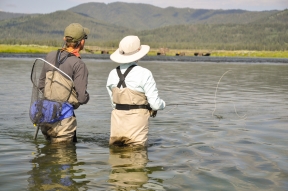
Earlier this year I posted some thoughts about etiquette and what is acceptable on our rivers. I stated that one of my personal gripes in recent years is loud music that is being played from drift boats without regard to the impact it has on other anglers. I also mentioned my concern that simple respect, common courtesy and consideration is getting lost in today’s fly fishing world. I asked for your thoughts. That post generated almost 200 comments. Many of the responses were focused on the music issue. There were lots of other great comments about etiquette and acceptable behavior. I wrote a follow up on a blog post entitled “Peace”.
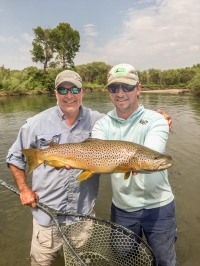
As expected, there were quite a few comments about guides and guiding. Comments included floating too close to other anglers, anchoring too close, trying to run other anglers out of the best spots, thinking they have priority, and basically an attitude that guides think they own the river. Other thoughts included too many guides and younger guides who weren’t trained and mentored about the importance of proper etiquette and professionalism. Other comments were not focused on behavior but rather an overall resentment such as exploiting the resource for personal gain. Some comments brought out a strong animosity toward non-residents. As often happens with Facebook, there were also some personal attacks and threats.
I’ve been in the outfitting and guiding business since 1974. My purpose here is not to respond to all of the comments but rather to offer my personal perspective on this touchy subject based on almost 45 years of knowledge and experience.
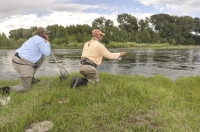
I want to start with some important facts. The outfitting and guiding industry is managed and regulated by both state and federal agencies. State management and governance varies wildly from state to state. Wyoming, for example, does not require a state guide or outfitting license for fishing. This means anybody can guide in Wyoming without liability insurance, bonding and other state requirements as long as they are on waters not under federal jurisdiction. We are legally licensed in both Idaho and Montana. I cannot comment on other states like Utah and Colorado because I don’t have a complete understanding of the requirements in other states.
I am not aware of any state with more stringent laws governing outfitting and guiding than Idaho. The Idaho Outfitters and Guides Licensing Board is a self-governing agency whose sole responsibility is to properly regulate the outfitting and guiding industry in Idaho for the purpose of safeguarding the health, safety, and welfare of the public. By definition outfitters are employers of guides and guides are employees of outfitters. There are no independent contractors. As employers, outfitters provide marketing and promotion, facilities and services, liability insurance, withhold payroll taxes and other related employer responsibilities.
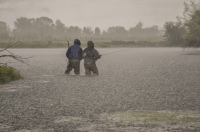
Each and every river and lake in the State of Idaho is limited to a specific number of outfitters. For example there are 8 outfitters legally licensed for the South Fork of the Snake, 7 for the Henry’s Fork and 5 for the Teton River. These restrictions on the number of river outfitters have been in place since before we opened Henry’s Fork Anglers in 1976. In fact, when we first started the only way we were able to begin legally guiding on the Henry’s Fork was to purchase an existing business from another outfitter.
Later the rules were amended to limit the number of guides that could legally float these rivers at any one time. For example, each outfitter on the South Fork can only have 12 guides on the entire river. Rivers are also broken into smaller segments. There are five float segments on the South Fork and not more than 4 boats are allowed by any individual outfitter in any section at one time. The result of these restrictions was evident in a recent study on the South Fork where the guided public accounted for less than 15% of the total use.
Montana is quite different from Idaho. Outfitter and guide licensing is governed by a board of outfitters but administered the State Department of Labor and Industry. The Board of Outfitters places no limits on the number of outfitters and guides licensed on any river in the state. While guides must be permitted through a licensed outfitter, most of them are hired as contract labor. There are many resident outfitting businesses based at a single location but there are also many nomadic outfitters and guides who roam across the state from river to river whenever the fishing is at its peak. The result on some rivers like the Madison is that the number of guided participants far outnumbers the non-guided public.
Once the toothpaste is out of the tube it is impossible to get it back in. Almost 30 years ago I served on a panel of Montana outfitters with Pat Barnes, Bud Lilly, Dick McGuire, and others in an effort to place guide limits and restrictions on Montana rivers. Our effort was a dismal failure. Eventually the Montana Department of Fish, Wildlife and Parks stepped in. Completely independent from the state board of outfitters, they implemented their own restrictions. This has resulted in a Special River Permit requirement on some rivers like the Big Hole, Beaverhead and Madison. Outfitters are limited to a restricted number of use days on the Beaverhead and Big Hole. I expect the same will happen on the Madison River.
Federal agencies also require special use permits to operate on managed public lands and waterways. For example, at Henry’s Fork Anglers we hold special use permits with the Ashton/Island Park and Palisades Ranger Districts of the Caribou-Targhee National Forest, the Hebgen Lake District of the Gallatin National Forest, the Bureau of Land Management, and the National Park Service. These federal agencies require valid state outfitter and guide licenses, proof of liability insurance and other requirements. Use day limits are also imposed which may or may not equal state restrictions. In addition fees are imposed according to the number of use days utilized by each outfitter.
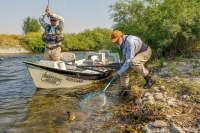
It’s hard to argue that there are too many guides on many rivers in states that impose no restrictions on the number of guides. In Idaho restrictions have been in place now for over 40 years. Long established outfitters like Henry’s Fork Anglers, Three Rivers Ranch and Teton Valley Lodge maxed out their use allocations long ago. For example, we average about the same number of guide trips each summer in Box Canyon that we did 25 years ago. Yet 25 years ago there were less than a quarter of the boat trailers parked at the take out than there are today. Who are the others? Just because the parking lot is full of trailers doesn’t mean they are all guides.
Another requirement of the Idaho Outfitters and Guides Licensing Board as well as individual federal agencies is that each boat must be marked with identification with a minimum of 3 inch letters of the employing outfitter. It’s easy to see on a busy day on the South Fork that the majority of float boats are not fishing guides. Yet I think there are some who believe that all or most drift boats they encounter on a given river are operated by fishing guides.
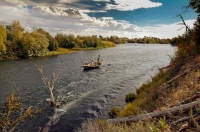
I can understand why there is resentment towards fishing guides. Many if not all of the comments on my Facebook post were valid as I have witnessed plenty of poor undisciplined behavior at one time or another. I have not hesitated to call the outfitter of the offending guide with a description of the guide, his boat and his offenses. In every case the outfitter has taken the responsibility to resolve the issue. That’s one advantage of the identification requirement on the boat. I know all 6 of the other legal outfitters on the Henry’s Fork. Above all else, all of us want to maintain the highest level of professionalism and integrity on and off the river. However sometimes managing a guide staff is a little like herding cats. If mistakes are made we want to know about it. A phone call or email reporting poor behavior by one of our employees is greatly appreciated. Remember in Idaho all guides are employees of an outfitter. They represent us. They work for us. Not only that, guides are part of a team, a fraternity. Bad behavior reflects poorly on everybody. All should not be judged badly by the unprofessional behavior of a few.
One major misconception about fishing guides is that they are doing the fishing in competition with the general public. First off, by Idaho law it is illegal for a guide to kill his client’s game or catch his client’s fish. It is not the guides who are doing the fishing. It is their clients, the guided public. The guided public is part of the general public. Over the years I have seen a change in attitude with regard to this issue both by the fishing public and some of the managing agencies.
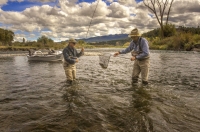
There have been instances where the guided public has been discriminated against simply on the basis that they hired a guide. The fishing season was not open on the Upper Henry’s Fork including the Box Canyon, Last Chance and the section above Mack’s Inn until a few years ago. After the regulations were changed by the Idaho Department of Fish and Game to allow year round fishing we received a letter from the forest service ranger stating that guiding would not be allowed on this section during the winter season. This meant that anglers who didn’t hire a guide could fish there but those who hired guides could not. Two years ago on the South Fork the forest service and BLM changed the legal put-in and take-outs for guides which denied their clients an opportunity to fish a back channel of the river above Conant that was still available to the non-guided public. It took a few letters, phone calls and meetings to remind these agencies that they serve all of the public, not just the portion of the public who don’t fish with guides.
There are those who believe that guides catch the most fish. Remember, it is the client fishing, not the guide. In most cases the number of trout his highly dependent upon the experience and skill level of the angler whether they fish with a guide or not. The fact is the majority of clients do not have the experience or skill level to hook and land large numbers of trout. If you hang out at one of the popular boat access points you’ll likely see a guide teaching his clients to cast. While it is true that a good experienced angler fishing with a competent guide can really light things up on the river it isn’t the norm. The majority of skilled experienced anglers do not need to fish with a guide to catch more and larger trout.
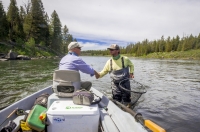
The argument that we exploit the resource for our own benefit is hard to defend because by definition it is true. My only comeback is that I believe what is beneficial to guides is equally beneficial to the non-guided public. Outfitters and guides who are not willing to give back to the resource that supports them should not be in business. Without the support of outfitters, guides and their clients it is doubtful organizations like the Henry’s Fork Foundation, Friends of the Teton River, Snake River Cutthroats, Teton Regional Land Trust and other organizations would be where they are today. Attend any of their fund raising events and you’ll find dozens of donated trips contributed by guides and the outfitters they work for. A look at the list of financial donors will also reveal the financial support from the local outfitting and guiding industry.
In the end we try to maintain the highest level of professionalism. If you ever witness undisciplined behavior by any guide with Henry’s Fork Anglers logo on his boat, please give us a call. If you see it from a guide who works for another outfitter I know they would also appreciate hearing from you.